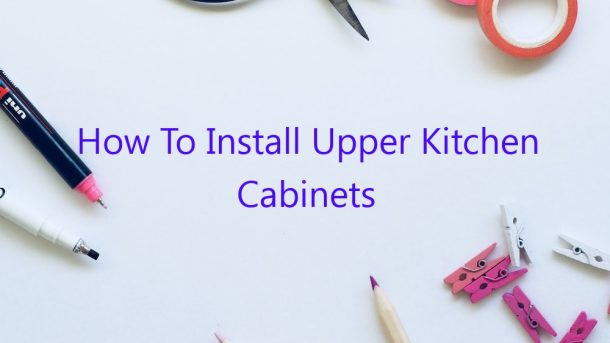Installing upper kitchen cabinets can be a daunting task, but with the right instructions, it can be a breeze. This article will outline the steps necessary to properly install upper kitchen cabinets.
Before beginning, ensure that you have the following tools and supplies:
-Tape measure
-Level
-Permanent marker
-Cordless drill
-1 inch hole saw
-Pilot hole drill bit
-Jigsaw
-Circular saw
-Paint or a sealant
-Screws
-Hinges
-Knobs or pulls
The first step is to measure the height and width of the opening in which you will be installing the cabinets. Be sure to measure from the top of the opening to the floor, and from one side of the opening to the other. Once you have the measurements, use a level to draw a horizontal line on the wall where you will be installing the cabinets. This line will ensure that the cabinets are level.
Next, use a tape measure to measure the height and width of the cabinet you will be installing. Be sure to measure from the top of the cabinet to the floor, and from one side of the cabinet to the other. Once you have the measurements, mark them on the wall with a permanent marker.
Now it is time to drill the pilot holes. Begin by drilling a pilot hole in the center of the horizontal line you drew on the wall. Next, use the pilot hole drill bit to drill a hole in the center of the cabinet marking on the wall. The pilot hole drill bit should be the same size as the screws you will be using.
Once the pilot holes have been drilled, it is time to install the cabinets. Be sure to read the instructions that come with the cabinets, as each brand may be installed differently. In general, the cabinets will be installed by screwing them to the wall. Begin by placing the cabinet against the wall and aligning the pilot holes. Once the cabinet is in place, use a drill with a screwdriver bit to screw the cabinet to the wall. Continue screwing the cabinet to the wall until it is securely in place.
Next, install the hinges. The hinges will be attached to the cabinet and the door. Begin by attaching the hinges to the cabinet. Be sure to follow the instructions that come with the hinges. Next, attach the hinges to the door. Again, be sure to follow the instructions that come with the hinges.
Finally, install the knobs or pulls. Knobs should be installed on the doors, and pulls should be installed on the drawers. Once the knobs or pulls have been installed, it is time to paint or seal the cabinets. Be sure to allow the paint or sealant to dry completely before using the cabinets.
That’s it! You have successfully installed your new kitchen cabinets.
Contents
- 1 How do you install upper cabinets yourself?
- 2 How are cabinets attached to the wall?
- 3 How high should upper cabinets be installed?
- 4 Should upper cabinets be installed first?
- 5 How do I secure my upper kitchen cabinets?
- 6 Is it difficult to install kitchen cabinets?
- 7 Are kitchen cabinets glued to the wall?
How do you install upper cabinets yourself?
Installing upper cabinets yourself is a great way to save money on your kitchen renovation. It’s also a great way to get the exact cabinet configuration that you want in your kitchen.
The first step in installing upper cabinets yourself is to measure the space between the upper cabinets and the ceiling. This will determine the height of the cabinets that you need to purchase.
Once you have the height of the cabinets that you need, it’s time to purchase them. Be sure to purchase cabinets that are the same height, or that have adjustable legs so that you can make them the same height.
The next step is to install the cabinet boxes. This is where the adjustable legs come in handy. If the cabinets are not the same height, you can use the adjustable legs to make them the same height.
Once the cabinet boxes are installed, it’s time to install the cabinet doors and the cabinet hardware. Be sure to follow the manufacturer’s instructions for installing the cabinet doors and the cabinet hardware.
It’s also a good idea to measure the distance between the upper cabinets and the countertop to determine the placement of the cabinet hardware.
If you are installing a countertop, be sure to install it before you install the upper cabinets.
Once the cabinet hardware is installed, it’s time to install the countertop.
If you are installing a countertop, be sure to install it before you install the upper cabinets.
Once the countertop is installed, it’s time to install the upper cabinets.
Be sure to follow the manufacturer’s instructions for installing the upper cabinets.
It’s also a good idea to measure the distance between the upper cabinets and the countertop to determine the placement of the cabinet hardware.
If you are installing a countertop, be sure to install it before you install the upper cabinets.
Once the upper cabinets are installed, it’s time to install the cabinet hardware.
Be sure to follow the manufacturer’s instructions for installing the cabinet hardware.
It’s also a good idea to measure the distance between the upper cabinets and the countertop to determine the placement of the cabinet hardware.
How are cabinets attached to the wall?
How are cabinets attached to the wall?
There are a few ways to attach cabinets to the wall. The most common way is to use screws and anchors. You can either use a drill to make a hole in the wall and then screw the anchor in, or you can use a power drill to screw the anchor in and then attach the cabinet to the anchor. Another way to attach cabinets to the wall is to use a metal bracket. The bracket is attached to the wall and the cabinet hangs from the bracket.
How high should upper cabinets be installed?
When it comes to installing cabinets in your kitchen, one of the most important decisions you’ll make is the height of your upper cabinets. If you install them too low, you’ll find yourself constantly bending over to access the contents of the cabinets. If you install them too high, you’ll lose valuable counter space. So, what’s the ideal height for upper cabinets?
The answer to this question depends on a number of factors, including the height of the person installing the cabinets and the height of the countertops. In general, however, upper cabinets should be installed at a height that allows the person installing them to stand comfortably and reach the top of the cabinets with ease.
If you’re unsure of the right height for your cabinets, it’s best to consult with a professional kitchen installer. They’ll be able to take into account the dimensions of your kitchen and help you choose the right height for your cabinets.
Should upper cabinets be installed first?
There are differing opinions on whether or not upper cabinets should be installed first when renovating a kitchen. Some experts believe that installing the upper cabinets first will help ensure that the walls are straight and will provide a better surface for attaching the cabinet to. Others believe that installing the lower cabinets first is the best way to go, as it allows you to get a better sense of the layout and provides a stable surface on which to install the upper cabinets. In the end, it is up to the individual homeowner to decide which method works best for them.
How do I secure my upper kitchen cabinets?
There are a few different ways that you can secure your upper kitchen cabinets. One way is to use cabinet locks. Cabinet locks can be used to keep your cabinets closed and also to keep them from being opened from the outside. Another way to secure your cabinets is to use cabinet straps. Cabinet straps can be used to keep your cabinets closed and also to keep them from being opened from the outside. You can also use a cabinet alarm to keep your cabinets secure. A cabinet alarm will sound when someone tries to open your cabinets.
Is it difficult to install kitchen cabinets?
Installing kitchen cabinets can be a daunting task for homeowners who are not experienced in carpentry. However, with a little patience and the right tools, it is a project that can be completed by most people.
The first step in installing kitchen cabinets is to measure the space where they will be installed. This includes measuring the height, width and depth of the space, as well as the height of the ceiling. It is important to take into account the size of the cabinets that will be purchased, as well as the distance between the cabinets and the appliances in the kitchen.
Once the measurements have been taken, the cabinets can be assembled according to the manufacturer’s instructions. Most cabinets come pre-assembled, but some may require assembly upon delivery. In addition, the hardware that will be used to install the cabinets, such as screws and brackets, should be gathered and prepared.
Next, the wall where the cabinets will be installed should be prepared. This includes removing any old cabinets or shelves, as well as cleaning the surface of the wall. The surface should be dry, level and free of debris before installing the cabinets.
If the cabinets are being installed against a wall, the brackets should be screwed into the wall studs. If the cabinets are not being installed against a wall, the screws should be inserted into the wall at an angle so that they will hold the cabinet in place.
The cabinets can then be installed by placing them against the wall or screws and brackets, and ensuring that they are level. The screws or brackets should then be tightened to secure the cabinets in place.
It is important to note that not all cabinets are installed in the same way, so it is important to read the manufacturer’s instructions carefully. Additionally, it is always a good idea to have a friend or family member who is experienced in carpentry help with the installation process.
Are kitchen cabinets glued to the wall?
Are kitchen cabinets glued to the wall?
Kitchen cabinets are usually fastened to the wall with screws or nails. However, there are some cabinets that are glued to the wall.
If your kitchen cabinets are glued to the wall, you should not try to remove them. You can damage the cabinets and the wall.
If you need to remove a cabinet that is glued to the wall, you should call a professional.




